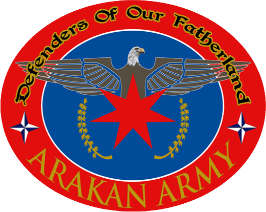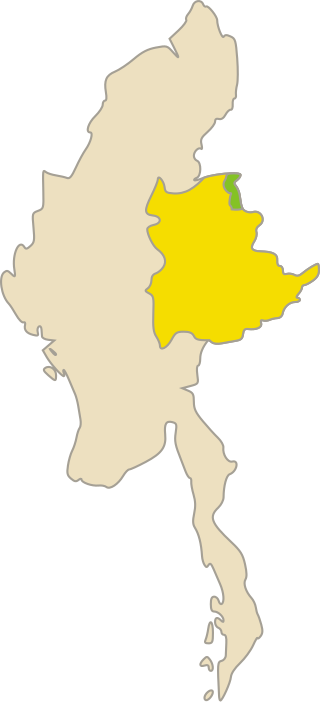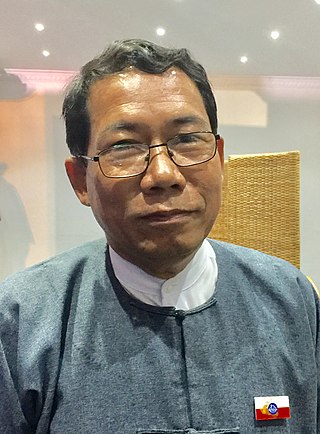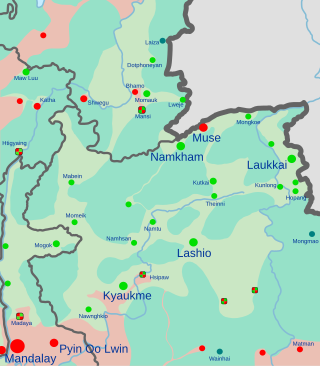Mong-Yu is a town in northern Shan State in Myanmar near the Chinese border. Mong-Yu is the location of the 105th mile trade zone. In 2019, it had a population of 1,730.

The United Wa State Army, abbreviated as the UWSA or the UWS Army, is the military wing of the United Wa State Party (UWSP), the de facto ruling party of Wa State in Myanmar. It is a well-equipped ethnic minority army of an estimated 20,000–30,000 Wa soldiers, led by Bao Youxiang. The UWSA was formed after the collapse of the armed wing of the Communist Party of Burma (CPB) in 1989.

The Kachin Independence Army is a non-state armed group and the military wing of the Kachin Independence Organization (KIO), a political group of ethnic Kachins in Northern Myanmar. The Kachins are a coalition of six tribes whose homeland encompasses territory in China's Yunnan, Northeast India and Kachin State in Myanmar.

Insurgencies have been ongoing in Myanmar since 1948, the year the country, then known as Burma, gained independence from the United Kingdom. The conflict has largely been ethnic-based, with several ethnic armed groups fighting Myanmar's armed forces, the Tatmadaw, for self-determination. Despite numerous ceasefires and the creation of autonomous self-administered zones in 2008, many armed groups continue to call for independence, increased autonomy, or the federalisation of the country. The conflict is the world's longest ongoing civil war, having spanned more than seven decades.

The Kachin conflict or the Kachin War is one of the multiple conflicts which are collectively referred to as the internal conflict in Myanmar. Kachin insurgents have been fighting against the Tatmadaw since 1961, with only one major ceasefire being brokered between them, which lasted from 1994 to 2011, a total of 17 years.

The Arakan Army, officially the Arakha Army is an ethnic armed organisation based in Rakhine State (Arakan). Founded on 10 April 2009, the AA is the military wing of the United League of Arakan (ULA). It is currently led by Commander-in-Chief Major General Twan Mrat Naing and vice deputy commander-in-chief Brigadier General Nyo Twan Awng. The Arakan Army states that the objective of its armed revolution is to restore the sovereignty of the Arakan people. In a February 2024 interview, Twan Mrat Naing claimed that the AA had grown to at least 38,000 troops. Anthony Davis, an expert of military and security, rejected this claim and estimated that it has at least 15,000 troops in Chin State and Rakhine State, in addition to around 1500 in Kachin State and Shan State. In the early 2010s, the Arakan Army fought alongside the Kachin Independence Army (KIA) against the Tatmadaw in the Kachin conflict. Following the 2016 outbreak of conflict in Rakhine state, AA became more heavily involved in the Arakan region. In 2019, AA launched attacks on state security forces and the Myanmar Army responded, heightening clashes. The AA reached a ceasefire in late 2020 after eroding the central government's control in northern Rakhine. The power vacuum was filled by the AA over the next 18 months with state-building efforts, like their COVID-19 vaccine rollouts.

The 2015 Kokang offensive was a series of military operations launched by the Myanmar Army in 2015 in Kokang in northern Shan State, Myanmar (Burma). Several clashes between the Myanmar Army and Myanmar National Democratic Alliance Army had taken place from February to May 2015.

The Ta'ang National Liberation Army in Myanmar (Burma), is the armed wing of the Palaung State Liberation Front (PSLF).

The Mon National Liberation Army is a Mon insurgent group in Myanmar (Burma). It is the armed wing of the New Mon State Party (NMSP), and has been fighting government forces since 1949, though under different names. The NMSP signed the Nationwide Ceasefire Agreement (NCA) on 15 October 2015 with several other insurgent groups and the government of Myanmar.

Aye Maung is a Burmese politician and was the chairperson of the Arakan National Party, one of Myanmar's ethnic political parties. He is currently the leader of the Arakan Front Party. He is a staunch nationalist known for his hardline stance against the Rohingya people, having tirelessly campaigned against the minority group and having been involved in instigating attacks against them in the communal violence in 2012.
Violent clashes have been ongoing in the northern part of Myanmar's Rakhine State since October 2016. Insurgent attacks by the Arakan Rohingya Salvation Army (ARSA) have led to sectarian violence perpetrated by Myanmar's military and the local Buddhist population against predominantly Muslim Rohingya civilians. The conflict has sparked international outcry and was described as an ethnic cleansing by the United Nations High Commissioner for Human Rights. In August 2017, the situation worsened and hundreds of thousands of refugees fled Myanmar into Bangladesh, with an estimated 500,000 refugees having arrived by 27 September 2017. In January 2019, Arakan Army insurgents raided border police posts in Buthidaung Township, joining the conflict and beginning their military campaign in northern Rakhine State against the Burmese military.
The Northern Alliance, officially the Northern Alliance – Burma, is a military coalition in Myanmar composed of four ethnic insurgent groups: the Arakan Army (AA), the Kachin Independence Army (KIA), the Myanmar National Democratic Alliance Army (MNDAA) and the Ta'ang National Liberation Army (TNLA). Since December 2016, the Northern Alliance has been in fierce military confrontations with the Tatmadaw in the towns of Muse, Mong Ko, Pang Hseng, Namhkam and Kutkai in Shan State. The Northern Alliance members are also part of the Federal Political Negotiation and Consultative Committee (FPNCC).
The 2018 Lashio bombing was a bomb blast in the town of Lashio, in northern Shan State, Myanmar, that killed two employees of Yoma Bank and injured 22 others.

Zaw Min Tun is a Burmese army general and the current Deputy Minister of Information in Myanmar. He serves concurrently as the Chief of the Tatmadaw True News Information Team and heads the Press Team of the State Administration Council (SAC). Zaw Min Tun is acknowledged as a senior spokesman for the Myanmar Army.

The People's Defence Force is the armed wing of the National Unity Government in Myanmar. The armed wing was formed by the NUG from youths and pro-democracy activists on 5 May 2021 in response to the coup d'état that occurred on 1 February 2021 that put the military junta and their armed wing the Tatmadaw in power. The military junta designated it as a terrorist organisation on 8 May 2021. In October 2021, NUG's Ministry of Defence announced that it had formed a central committee to coordinate military operations across the country.

The Myanmar civil war, also called the Burmese Spring Revolution, Burmese civil war or People's Defensive War, is an ongoing civil war following Myanmar's long-running insurgencies, which escalated significantly in response to the 2021 military coup d'état and the subsequent violent crackdown on anti-coup protests. The exiled National Unity Government and major ethnic armed organisations repudiated the 2008 Constitution and called instead for a democratic federal state. Besides engaging this rebel alliance, the junta also contends with other anti-junta forces in areas under its control. Hannah Beech of The New York Times observed the insurgents are apportioned into hundreds of armed groups scattered across the country.
The following is a timeline of major events during the Myanmar civil war (2021–present), following the 2021 military coup d'état and protests. It was also a renewed intensity in existing internal conflict in Myanmar.

Operation 1027 is an ongoing military offensive conducted by the Three Brotherhood Alliance, a military coalition composed of three ethnic armed organisations in Myanmar: the Arakan Army (AA), Myanmar National Democratic Alliance Army (MNDAA), and Ta'ang National Liberation Army (TNLA), allied with other rebel forces in the country, against the Tatmadaw, Myanmar's ruling military junta.
The Three Brotherhood Alliance ;, also known as Brotherhood Alliance, is an alliance between the Arakan Army, Myanmar National Democratic Alliance Army, and the Ta'ang National Liberation Army formed in June 2019.
The Kachin Independence Army's (KIA) offensive in Kachin State, known unofficially as Operation 0307, is an ongoing military operation against the Tatmadaw military junta of Myanmar which began on 7 March 2024. Primarily centred along the road connecting Myitkyina to Bhamo, Operation 0307 was launched to capture junta bases which could threaten Laiza, the headquarters of the KIA. Operation 0307 was launched alongside concurrent KIA offensives against Hpakant and northern Shan State, and concurrent resistance offensives throughout Myanmar.











